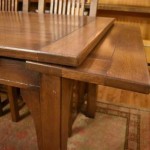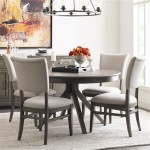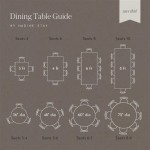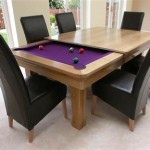Selecting the Perfect Rug for an Oval Dining Table
The dining room serves as a central gathering space in many homes, a place for meals, conversations, and shared moments. An oval dining table, with its elegant curves and space-saving design, offers a unique aesthetic. However, choosing the right rug to complement an oval dining table requires careful consideration of several factors. The rug not only enhances the room's visual appeal but also provides practical benefits, such as noise reduction and floor protection. The improper selection of a rug can disrupt the room's flow and diminish its overall design impact. This article explores essential aspects to consider when choosing a rug for an oval dining table, ensuring a harmonious and functional dining space.
Determining the Appropriate Rug Size and Shape
The size and shape of the rug are paramount considerations. The rug needs to be large enough to accommodate all chairs when they are pulled out from the table, allowing diners to move freely without the chair legs catching on the rug's edge. A rug that is too small will create a cramped and unbalanced appearance, while one that is excessively large can overwhelm the room. A general guideline is to add at least 24 to 36 inches to the length and width of the oval table to ensure that the chairs remain entirely on the rug even when occupied.
For an oval dining table, the shape of the rug is also a significant factor. While a rectangular rug is a common choice, it is essential to select one that aligns well with the oval table's proportions. A rectangular rug that is too narrow will create a visually awkward space around the table. An oval or round rug can echo the shape of the table, creating a cohesive and balanced look. A square rug can also work, particularly in larger dining rooms, providing a contrasting geometric element that can add visual interest. If opting for a rectangular or square rug, it's important to ensure the corners do not intrude into walkways or disrupt the flow of traffic within the room.
To visualize the rug's placement and size, masking tape can be used to outline the proposed rug area on the floor. This allows for a tangible representation of the rug's presence and helps evaluate its impact on the surrounding space. It also helps determine if the rug's dimensions are appropriate for accommodating chairs and maintaining comfortable walkways around the table.
Considering Rug Material and Pile Height
The material and pile height of the rug are crucial for both aesthetics and practicality. The choice of material will influence the rug's durability, maintenance requirements, and overall texture. Natural fibers like wool, cotton, and jute offer distinct advantages and disadvantages. Wool rugs are known for their durability, stain resistance, and luxurious feel. They are a good choice for high-traffic areas but can be more expensive than other options. Cotton rugs are softer and more affordable but may be less durable and more prone to staining. Jute rugs offer a natural, textural appeal and are relatively durable but can be rougher underfoot.
Synthetic fibers like nylon, polyester, and polypropylene provide alternatives with varying degrees of durability and stain resistance. Nylon rugs are extremely durable and resistant to wear and tear, making them suitable for busy households. Polyester rugs are soft and often less expensive than nylon, but they may not be as resistant to crushing and fading. Polypropylene rugs are highly stain-resistant and easy to clean, making them a practical choice for dining areas where spills are likely.
The pile height of the rug refers to the length of the fibers. A low-pile rug, typically less than 0.25 inches, is easier to clean and less likely to trap crumbs or debris. This makes it a practical choice for dining areas. A high-pile rug, exceeding 0.5 inches, offers a more luxurious and comfortable feel underfoot but can be more challenging to clean and may not be suitable for dining spaces where chair movement is frequent. Medium-pile rugs, between 0.25 and 0.5 inches, strike a balance between comfort and practicality.
When selecting a rug for an oval dining table, the type of use it will endure should influence the rug pile. A family with small children and frequent meals will fare better with a low pile rug that is easy to clean. A more formal setting that is used infrequently may be more suitable for a high-pile rug that provides a soft and luxurious feel.
Evaluating Rug Design and Color Palette
The rug's design and color palette should complement the existing décor of the dining room, including the furniture, wall color, and accessories. The rug can serve as a focal point, adding visual interest and personality to the space. Alternatively, it can blend seamlessly with the surrounding elements, creating a cohesive and harmonious look. The design and pattern of the rug should align with the overall style of the dining room, whether it is traditional, modern, or eclectic.
A rug with a bold pattern or vibrant colors can add energy and dynamism to a neutral dining room. Conversely, a rug with a subtle pattern or muted colors can create a calming and sophisticated atmosphere. If the dining room features patterned wallpaper or upholstery, it is important to choose a rug design that does not clash with these elements. Opting for a rug with a complementary pattern or a solid color can help avoid visual overload. Consider the scale of the pattern as well. A small, intricate pattern can add a delicate touch, while a large, bold pattern can make a statement.
The color palette of the rug should harmonize with the existing colors in the dining room. A rug with colors that echo the wall color or the furniture upholstery can create a sense of continuity. Alternatively, a rug with contrasting colors can add visual interest and create a focal point. When selecting colors, consider the lighting in the dining room. Natural light can enhance colors, while artificial light can alter their appearance. Testing color samples in the room under different lighting conditions can help ensure that the chosen rug color complements the overall aesthetic.
Neutral rugs, such as beige, gray, or cream, offer versatility and can be easily incorporated into a variety of décor schemes. These colors provide a timeless and elegant backdrop for the dining table and chairs. They also allow other elements in the room to take center stage. However, dark-colored rugs can add drama and sophistication, particularly in larger dining rooms. Dark colors can also help conceal stains and dirt, making them a practical choice for high-traffic areas.
Considering Budget and Maintenance
The budget allocated for the rug is a fundamental consideration. Rug prices vary significantly depending on the material, size, design, and brand. Setting a budget beforehand helps narrow down the options and avoid overspending. It is important to balance the desired quality and aesthetic with the available funds. Investing in a high-quality rug made from durable materials can be a worthwhile investment in the long run, as it will withstand wear and tear and maintain its appearance over time.
Maintenance requirements are another crucial factor to consider. Some rugs require more frequent cleaning and care than others. Wool rugs, for example, may need professional cleaning to maintain their appearance and prevent damage. Synthetic rugs, on the other hand, are often easier to clean and can be spot-cleaned with mild detergent and water. It is essential to consider the lifestyle and habits of the household when selecting a rug. A family with pets or young children may benefit from choosing a rug that is stain-resistant and easy to clean.
Regular vacuuming is essential for maintaining the appearance and longevity of any rug. Vacuuming removes dirt, dust, and debris that can accumulate in the fibers and cause wear and tear. Using a vacuum cleaner with a brush roll can help loosen and remove embedded dirt. However, it is important to avoid using a vacuum cleaner with excessive suction, as this can damage the rug fibers. Consider the cost of professional cleaning services and the frequency with which these services may be required to maintain the rug's appearance over time.
A rug pad placed underneath the rug offers several benefits, including cushioning, noise reduction, and floor protection. It also helps prevent the rug from slipping or sliding on the floor. A rug pad can extend the life of the rug by reducing wear and tear and preventing it from becoming misshapen. The rug pad also adds an extra layer of insulation, making the dining room more comfortable.
Addressing Specific Challenges of Oval Dining Tables
Oval dining tables present unique challenges when selecting a rug. The elongated shape of the table can make it difficult to find a rug that fits perfectly and complements the overall design. It creates a longer expanse, which can be harder to unify visually with the right rug. Unlike rectangular or square tables, the oval shape requires careful consideration of proportions and scale to avoid creating a visually unbalanced space.
One of the most common challenges is determining the appropriate rug size for an oval table. The rug needs to be large enough to accommodate all chairs when they are pulled out from the table, but it also needs to be proportional to the size of the room. A rug that is too small will look out of place, while one that is too large will overwhelm the space. Using the guidelines of adding 24 to 36 inches to the length and width of the table is a good starting point, but it is also important to consider the dimensions of the room and the placement of other furniture.
Another challenge is selecting the right rug shape for an oval table. While an oval or round rug can echo the shape of the table and create a cohesive look, a rectangular rug can also work if it aligns well with the table's proportions. A square rug can provide a contrasting geometric element, but it may not be suitable for smaller dining rooms. The choice of rug shape will depend on the overall design aesthetic and the size and shape of the room.
The placement of the rug under the oval table is also crucial. It is important to ensure that the rug is centered under the table and that the perimeter of the rug is evenly spaced around the table. This creates a balanced and harmonious look. If the rug is not centered or the perimeter is uneven, it can create a visually awkward space.

3 X 5 1 Hand Braided Jute Oval Rug

Rules Of Thumb For Rugs Under Round Dining Tables Inspiration

6 Rules For Choosing A Dining Room Rug Pretty Sources Stonegable

What Size Rug Under Dining Table Here S The Best Way To Find Righ

Dining Rooms Oval Jute Rug Design Ideas

Open Dining Room With Tons Of Sunlight

Oval Dining Table On Black And White Stripe Rug Transitional Room

Dining Room New Oval Table And Plans Nesting With Grace

Simple Rules For Dining Room Rugs Floorspace

The 14 Best Boho Dining Room Rugs Of 2024








